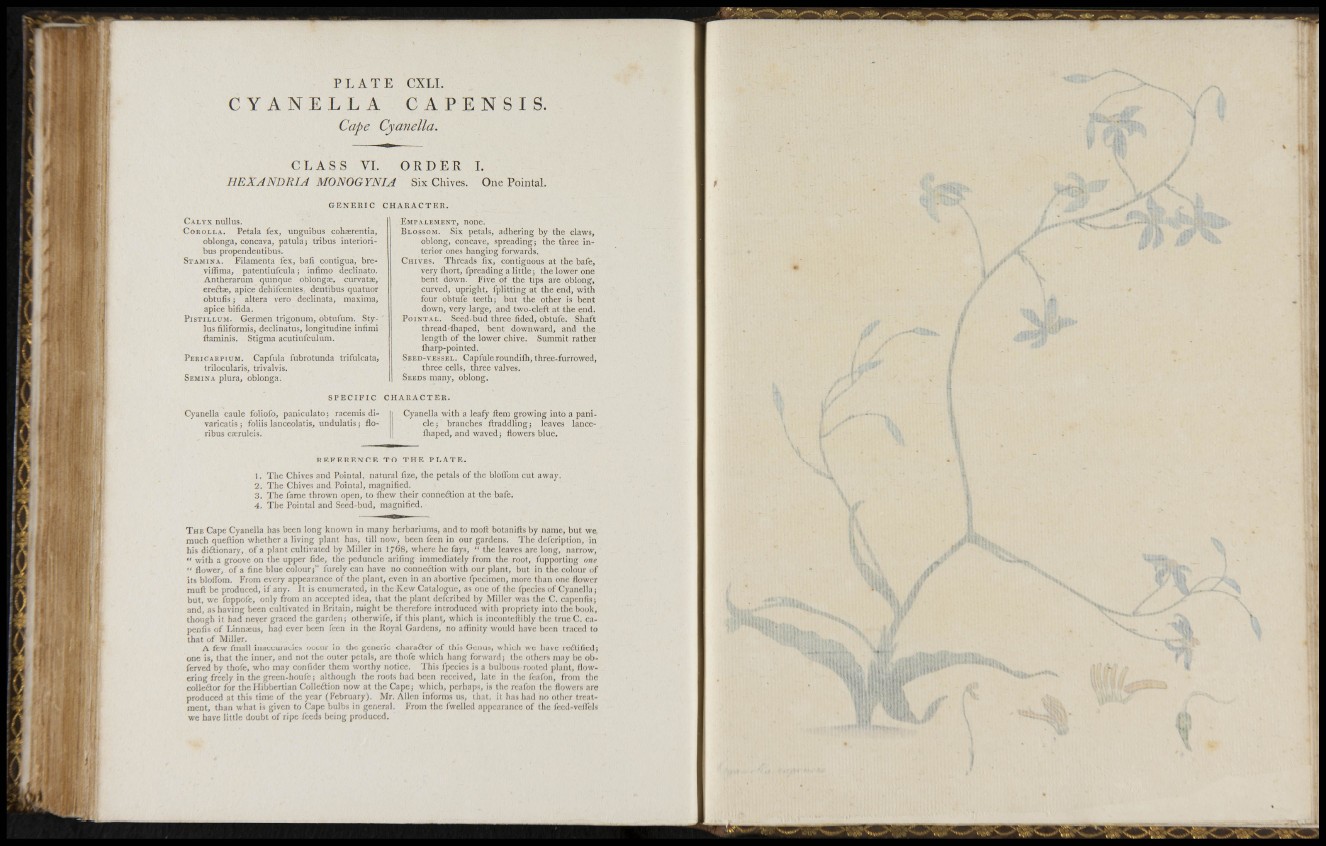
P L A T E CXLI.
C Y A N E L L A CAPENSIS.
Cape Cyanella.
C L A S S VL ORDER L
HEXANDRIA MONOGYNIA Six Chives. One Pointal.
G E N E R I C CHARACTER.
CALYX nullus.
COROLLA. Pétala fex, ungulbus coheerentia,
oblonga, concava, patula; tribus interioribus
propendeiitibus.
STAMINA. Filamenta iex, bafi contigua, breviffima,
patentiulcula ; infimo declinato.
Antherarnm quinqué oblongae, curvatse,
erefl:^, apice dehilcentes- dentibus quatuor
obtufis ; altera vero declinata, maxima,
apice bifida.
PISTILLUM. Germen trigonum, obtufum. Stylus
filifi^rmis, declinatus, longitudine infimi
ftaminis. Stigma acutiufculum.
PERICAKPIUM. Capfiila fubrotunda trifulcata,
trilocularis, trivalvis.
SEMINA plura, oblonga.
EMPALEMENT, none.
BLOSSOM. Six petals, adhering by the claws,
oblong, concave, spreading; the three interior
ones hanging forwards.
CHIVES. Threads fix, contiguous at the bafe,
very fliort, fpreading a little; the lower one
bent down. Five of the tips are oblong,
curved, upright, fplitting at the end, with
four obtufe teeth; but the other is bent
down, very large, and two-cleft at the end.
POINTAL. Seed-bud three fided, obtufe. Shaft
thread-fliaped, bent downward, and the
length of the lower chive. Summit rather
lliarp-pointed.
SEED-VESSEL. Capfule roundilli, three-furrowed,
three cells, three valves.
SEEDS many, oblong.
S P E C I F I C CHARACTER.
Cyanella caule foliofo, paniculato: racemis divaricatis;
foliis lanceolatis, undulatis; floribus
cseruleis.
Cyanella with a leafy ftem growing into a panicle;
branches fi:raddling; leaves lancefliaped,
and waved; flowers blue.
R E F E R E N C E TO THE PLATE.
1. Tlie Chives and Pointal, natural fize, the petals of the blotroni cut away.
2. The Chives and Pointal, magnified.
3. The fame thrown open, to iliew their connexion at the bafe.
4 . Tlie Pointal and Seed-bud, magnified.
THE Cape Cyanella has been long known in many lierbariurn.s, and to moft botanifts by name, but we,
much queftion whether a living plant has, till now, been feen in our gardens. Tiie defcriplion, in
his diiitionary, of a plant cultivated by Miller in 1/08, wliere he fays, " the leave.s are long, narrow,
" with a groove on the upper fide, the peduncle arifing immediately from the root, fnpporting one
" flower, of a fine blue colour;" furely can have no conneilion with our plant, but in tlie colour of
its blolfom. From every appearance of tlie plant, even in an abortive fpecimen, more than one (lower
muft be produced, if any. It is enumerated, in the Kew Catalngne, as one of the fpccies of Cyanella;
but, we fuppofe, only from an accepted idea, that the plant defcribed by Miller was the C. capcntis;
and, as having been cultivated in Hritain, might be therefore introduced with pro|)riety into Ihebook,
though it had never graced the garden; oliierwife, if ihis plant, which is inconteilibly Ihe true C. capenfis
of Linnxus, had ever been feen in the itoyal Gardens, no atlinity would have bci^n Iraced to
that of Miller.
A few fmall inaccuracies occur in the generic charaiter of this Genus, whicli we have reitificd;
one is, that the inner, and not the outer petals, are thofe which hang forward; the others may be obferved
by Ihofe, who may confider them worthy notice. This fpccies is a bulbous rooled plant, flowering
freely in tlie green-houfe; althougli the roots had been received, lale in Ihe feafoil, from llie
collector for thel l ibbert ian Collc6tion now at the Cape; wiiich, perhaps, i.s (he reaibn Ihe flowers are
produced at this lime of the year (I'ebruary), Mr, Allen inforins us, ihat. it has had uo other treatment,
than what is given to Ca >c bulbs in ge/jeral, I'Vom the fwelled appearancc of Ihc fecd-velfels
we have little doubt of ripe feeds being produced.